Introduction
Within This Page
The USGBC (U.S. Green Building Council) has implemented the LEED® (Leadership in Energy and Environmental Design) program to encourage clients and professionals to design, build, and operate more environmentally appropriate buildings. LEED goals are organized into seven categories:
- Integrative Process
- Location and Transportation
- Water Efficiency
- Energy and Atmosphere
- Materials and Resources
- Indoor Environmental Quality
- Innovation
This Resource Page focuses on LEED issues that impact the owner, the architectural/engineering team, and the contractor working on laboratory building projects.
For the owner, an overview of the issues that specifically affect them and information that clarifies potential cost ramifications are provided.
Possible solutions to these challenges are identified through architectural/engineering design ideas discussed in this Resource Page, many of which have been considered good design for some time. Others reflect a change in the marketplace due to the LEED process and a basic understanding of potential initial cost, as well as payback analysis for some items. Also identified are solutions that provide a higher quality laboratory building but may have costs difficult to quantify.
The third area of focus is the contractor. Some solutions provided in this Resource Page indicate how to address LEED specifications or formulate a contract that encourages the contractor to be proactive. Items that must be determined, addressed, and documented by the contractor primarily during the construction phase are specified as well.
The U.S. Green Building Council (USGBC) is currently working under version LEED v4.1. Other actions in recent years include:
-
Keeping LEED 2009 open for registration for three years.
-
Continuing to ask for the market's assistance in "test driving" LEED v4 to gain important insight during a time when improvements in usability infrastructure can be made.
-
Committing to a fifth public comment that will open on Oct. 2, 2012, and run through Dec. 10, 2012 to take advantage of Greenbuild where USGBC will hold public forums and educational sessions on site in San Francisco. This will help stakeholders better understand requirements as well as any final changes that may appear in the new draft. Greenbuild will also serve as a platform to debut new forms, submittal documents and LEED Online enhancements that will help improve and enhance the user experience.
For more information, please visit www.usgbc.org/leed.
The USGBC is committed to a prosperous and sustainable future through cost-efficient and energy-saving green buildings. USGBC works toward its mission of market transformation through its LEED green building certification program, robust educational offerings, a nationwide network of chapters and affiliates, the annual Greenbuild International Conference & Expo, and advocacy in support of public policy that encourages and enables green buildings and communities.
The current LEED 2009 BDTC rating system is comprised of 100 base points, with up to 10 additional points available in Innovation in Design and Regional Priority categories. In addition, all 8 prerequisites must be met.
Description
1. Sustainable Sites
While the solutions for Sustainable Sites usually have little impact on the contractor, they do impact the client/owner and the architectural/engineering team.
For the client/owner, a total of 26 of 100 points are achievable in this category. In fact, most projects receive at least 75% of these points because they are usually attainable without adding to the initial construction cost. For example, many points are achieved because of the program and site, not because of a LEED goal. Items such as Site Selection (SS Credit 1), Urban Redevelopment (SS Credit 2), Brownfield Redevelopment (SS Credit 3), Alternative Transportation (SS Credit 4), and Reduced Site Disturbance (SS Credit 5) are usually determined by the owner because of an existing campus and buildings or a preselected building site. There are, however, some design opportunities that have modest construction cost and potential paybacks during operational costs.
The architectural/engineering team has a range of design options that impact a sustainable site. For example, in the section on alternative transportation, bicycle storage and changing rooms (SS Credit 4.2), a solution can be reached if bike storage and changing rooms are provided in an adjacent building or within the new project. Since many laboratory projects require a changing area for the researchers, this is addressed in the design phase. And while bike racks may add a modest cost to the project (approximately $5,000), it has a qualitative payback.
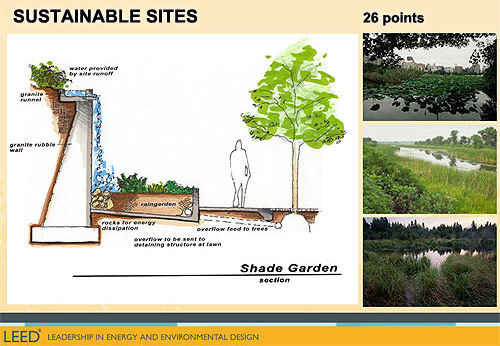
Other areas where the A/E team can provide design solutions include:
- Alternative Transportation, parking capacity (SS Credit 4.4), achieved by creating designated van pool spaces which will not add cost to the project.
- Reduced Site Disturbance, protect or restore open space (SS Credit 5.1) by using indigenous plants and developing a more natural landscape solution will help to achieve this credit without adding any cost to the project. Choosing plants that need little water and no irrigation system will reduce the operational costs associated with an irrigation system.
- Storm Water Management, rate and quantity (SS Credit 6.1) by addressing roof run-off on the site. Cisterns, rills, and rain gardens are common solutions that have immediate payback and savings.
- Storm Water Management, treatment (SS Credit 6.2)
- Heat Island Effect, non-roof (SS Credit 7.1)
- Heat Island Effect, roof (SS Credit 7.2)
- Reduced Light Pollution (SS Credit 8), which can be achieved by using only pedestrian level lighting and reducing construction and operational costs with less nighttime lighting.
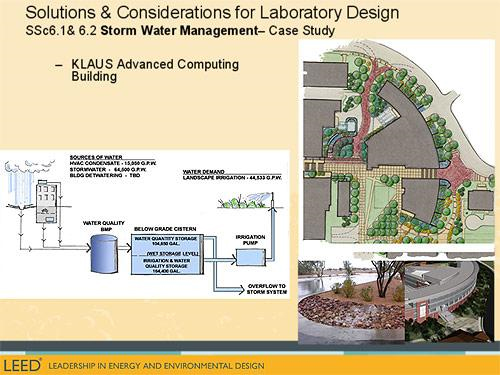
See WBDG Achieving Sustainable Site Design through Low Impact Development Practices, Low Impact Development Technologies, Extensive Vegetative Roofs.
2. Water Efficiency
Many of the ideas in this category have been developed because of the push for more sustainable buildings in the last 5+ years by the government, nonprofit, and private entities. For the client/owner, efficient design solutions improve the overall quality of the building with modest initial construction costs with less than five years for the operational payback.
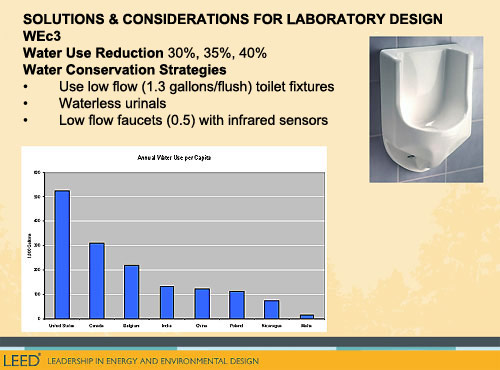
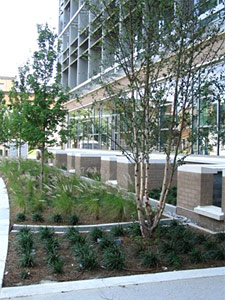
Condensate used to irrigate landscape during the hot summer months
Water Efficient Landscaping (WE Credits 1) can be achieved with a smart condensate recovery design by the A/E team. In most wet lab buildings, there is a significant amount of condensate generated from the air handlers. The condensate is generated during hot periods when the air-conditioning is necessary to cool spaces. The hot time of the year is usually the dry time in most parts of the country meaning the availability of condensate is at an opportune time.
Water Use Reduction (WE Credits 3) is very difficult to achieve in most laboratory buildings because of the need for cooling equipment with chilled water, requirements for safety showers and eyewashes, as well as general use needs in the labs. Vivarium facilities with cage wash systems and sterilizers will also use a tremendous amount of water.
See WBDG Water Conservation.
3. Energy and Atmosphere
The Energy & Atmosphere section focuses primarily on engineering issues and solutions based on building systems working together for a more comprehensive solution. Computer modeling is an important, efficient way to study and evaluate how various ideas impact other systems by examining different options based on the A/E team's recommendations. It should be completed at the end of schematic design, since the team will need time to develop some conceptual ideas and a preliminary design solution. The process usually takes two to four weeks, enabling decisions on building systems to be finalized before getting too far in the design development phase.
DOE-2 Computer Modeling and Payback Analysis
The University of Minnesota Molecular and Cellular Biology Building is a 243,000 gross square-foot facility located on the University of Minnesota East Bank campus. Northern States Power Company developed a DOE-2 model, a sophisticated energy performance simulation program. The energy cost is estimated at $1,406,353 per year at code level. The following is a list of issues that resulted from the study with the design team involved.
-
Heat recovery saves the most dollars because of the large amount of heat required and the relatively high cost of University of Minnesota steam; it saves relatively few kW however (8.0 peak savings), as most of the savings is in heating energy ($309,933 annual energy savings).
-
Improving the chiller efficiency saves the most kW (403.4) and a relatively large amount of energy dollars as well ($46,348).
-
Variable speed drives decreased fan static, day lighting and lab variable air volume also show strong kW savings potential (218.4), but relatively less dollar savings ($39,843).
Engineering options are extremely important for most laboratory buildings because they are energy 'hogs'. The typical wet laboratory uses five-times as much energy and water per square-foot as the typical office building because of intensive ventilation requirements and other health and safety concerns.
Research laboratories are energy demanding for a variety of reasons:
- Safety requirement for once-through air
- Large quantity of containment and exhaust devices
- Large quantity of heat-generating equipment
- 24-hour access requirement by scientists
- Irreplaceable experiments requiring fail-safe redundant back up systems and UPS or emergency power
Examining energy and water requirements from the holistic building perspective can identify significant opportunities to improve efficiencies while continuing to meet or exceed health and safety standards. New technologies on the market should be evaluated in order to take advantage of them once they become more affordable. Such technologies include fuel cells, photovoltaic panels and super insulating windows.
Optimizing Energy Performance (EA Credit 1)
Design opportunities for optimizing energy performance are worth considering, including:
- Lab and non-lab zoning. If large enough (approximately 7,500 to 10,000 sf), a non-lab area can be built using standard office construction with re-circulated air and less stringent temperature and humidity controls. An airside economizer can be used for the offices, atrium, meeting rooms and other support areas, providing an HVAC cost savings of 5-10% for the non-lab part of the building.
- Energy efficient glazing.
- Exterior louvers and sun shades at appropriate facades.
- Energy recovery system.
- Variable speed exhaust systems, a payback within one to three years for most wet labs.
- Occupancy and photo sensors.
- High-performance fume hoods.
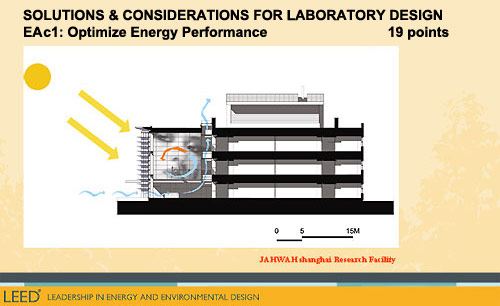
Computer modeling will reveal information vital to laboratory design because of the complexity of the building type. Some solutions are not appropriate for all laboratories. For example:
- In the southern region of the U.S., increasing the R value of insulation in walls and ceilings may not be appropriate for labs that generate a fair amount of heat from the equipment. It is better to allow the heat to go up and out of the building than to add insulation and have to cool a higher amount of heat in the spaces.
- Enthalpy wheels for energy recovery may not be appropriate for safety concerns.
- Variable Air Volume fume hoods are not cost-justified for all labs.
The following are some design guidelines to consider:
Code Minimum Requirements
| Parameter | Value | Source | Standard | Design Target |
|---|---|---|---|---|
| Ventilation | 20 cfm/person | ASHRAE 62.1 2007 | same | Maximize outdoor air by using displacement ventilation Deliver air low/ exhaust high |
| Filtration | none | 35-80% | 65% pre-filter 85% final filter |
|
| Indoor Design Temperature | 75F summer 72F winter |
same | ||
| Humidity Control | NA | 50% RH summer 40% RH winter |
||
| Equipment Heat Dissipation | NA | 3-4W/ sf | 1.5W/ sf or 2W/ sf with 75% diversity factor | |
| Toilet Exhaust | 50cfm/ fixture | ASHRAE 62.1 2007 | same | 2 cfm/ sf |
| Lighting Power Loads | NA | 2W/ sf All direct |
0.5-0.75W/ sf Total task/ ambient with Occupancy sensors & Daylight sensors |
|
| Lighting Loads | 100 ft candles | same | 20-30 ft candles with Ambient and task lighting | |
| Building Shell Infiltration | 6 /100 sf | ASHRAE | 3 /100 sf | 1.5 /100 sf (Canadian Standard) |
| Building Shell Infiltration (alternate) | 0.80 cfm/ sf | 0.30 cfm/ sf | 0.10 cfm/ sf | |
| Exterior Wall Insulation | U= 0.28 btu/ sf-hr F |
BOCA Energy Code | U=0.10 btu | U= 0.15 btu/ sf-hr South U=0.05 btu/ sf-hr N,E, W |
| Exterior Wall Moisture Control | A/B-With insulation both sides | |||
| Roof Insulation | U= 0.07 btu/ sf-hr | BOCA Energy Code | U=0.05 btu/ sf-hr | U= 0.05 btu/ sf-hr with low surfacing |
| Windows | ||||
| Glazing type | single/ clear | double/ clear | heat reflecting clear | |
| Visible transmittance | 0.80 | 0.78 | 0.70 | |
| Shading Coefficient | 1.00 | 0.80 | 0.43 | |
| U value | 1.04 | 0.48 | 0.30 | |
| Heating Degree Days | 6,155 btu | ASHRAE | same | determined by DOE2 analysis of TMY data |
See WBDG Building Integrated Photovoltaics (BIPV), Cool Metal Roofing, Daylighting, Distributed Energy Resources (DER), Electric Lighting Controls, Energy Efficient Lighting, Extensive Vegetative Roofs, Fuel Cells and Renewable Hydrogen, High-Performance HVAC, Microturbines, Natural Ventilation, Passive Solar Heating, Sun Control and Shading Devices, Windows and Glazing.
Enhanced Commissioning (EA Credit 3)
For complex wet laboratories additional commissioning is necessary to ensure the HVAC system is balanced properly, that daily operational maintenance processes are implemented properly, and that all safety requirements are met.
The commissioning is an important area that the entire team—including the contractor—needs to understand and buy into during the programming phase. Enhanced Commissioning is one of the few LEED points that requires early commitment. The initial cost is paid back to owners of laboratory facilities in usually less than three years.
See WBDG Building Commissioning.
Measurement and Verification (EA Credit 5)
Laboratory buildings require a higher level of monitoring than is provided by most Building Control Systems for fume hood controls, lighting sensors, humidity and temperature controls, and room air pressurization.
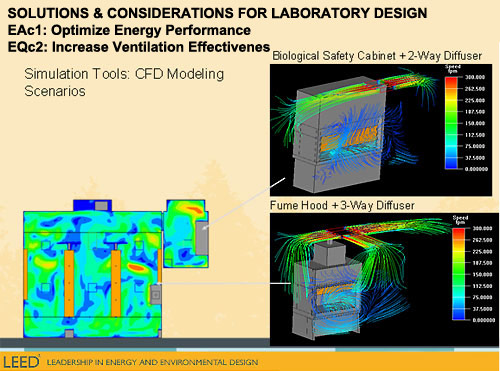
HVAC
It is essential practice to consider the whole HVAC system design and analyze assumptions using whole-building systems software. Reducing the overall building loads is a good place to start. Initial and operational costs can be trimmed by using smaller equipment; for example, using natural convection to exhaust air in the atrium to eliminate the need for a separate air handler.
Other ideas include:
- Using electronic air cleaners to help minimize air resistance from filters.
- Maintaining effective filter replacement schedules.
- Insulating hot water, steam, and chilled water piping.
- Using control systems for variable speed drives on pumps, fans and compressors only if the controls are maintained and calibrated regularly.
- Keeping condenser water as cool as possible but not less than 20 degrees above chilled water supply temperature.
- Reusing wasted heat with a heat recovery system.
- Installing an economizer at the boiler. The water-side economizer will help with humidity controls.
- Maintaining hot water for washing hands at 105 degrees F.
- Using local hot water tanks at kitchens, rest rooms and other areas instead of central hot water.
- For plumbing systems, installing ultra-low-flow toilets (0.5 gallons per flush) and automated controls such as infrared sensors for faucets.
- Implementing a cascade airflow from offices to labs.
- Installing HVAC systems can be sized for 70-80% of peak ventilation. Small, single-room labs should be sized for 100% capacity without downsizing.
- Carefully considering the number of fume hoods necessary. Each hood uses as much energy in a year as an entire house!
Determining how to eliminate microbial growth in HVAC system is crucial. Drip pans or any area where water might sit for a period of time should be eliminated. The biggest problem is usually at the cooling coils because they are wet all the time. Ultra-violet lights can be used to kill the microbial growth, but the lights are expensive and difficult to maintain.
See WBDG High-Performance HVAC.
Fume Hoods
Many factors must be considered when choosing the right laboratory fume hood, including how the hood will be used and how its placement affects its laboratory design. Worker safety and containment performance are of primary importance. Secondary considerations should be energy consumption and the cost to install, operate and maintain the hoods and supporting HVAC systems. The following must be carefully considered when making an informed decision regarding fume hood selection:
-
How many hoods does the project require? The greater the number of hoods, the stronger the argument for choosing a high performance hood that operates on the lowest air volume (assuming safe containment). The average 6' laboratory fume hood uses as much energy as the average American home in a year. One hood in a lab will not likely affect HVAC system size, and a conventional hood may be adequate and cost less. However, reducing the air volume required on 100 or 200 hoods can have a drastic affect on the sizing of the HVAC system, and reducing the size of the system could literally save millions of dollars.
-
What face velocity should be the basis of design? Requirements and codes vary throughout the country. What is necessary to provide maximum containment and safety? Is there a specific face velocity required, and if so, is it worth the time and expense of pursuing a variance to try to have a lesser velocity approved by the code enforcement officials? Again, the more hoods, the more potential for cost savings through reduced air volume.
The face velocity design criteria selected should provide a margin of error to take into account less than ideal conditions. The entire design team should work together to establish the proper baseline for each project.
High performance fume hoods are demonstrating better performance and containment at less air volume and face velocity. Subsequent energy efficiency and operating costs will save owners money, and they may be safer than conventional hoods.
Many things affect hood performance. Even the safest fume hoods can spill and expose workers if other factors are not carefully considered, including:
- Proper placement in the laboratory and proper design of the space.
- Cross drafts caused by the HVAC supply air system—proper placement, flow volume, and balance of the room.
- Proximity to opening/closing doors.
- Possible fluctuations in room pressure.
- Traffic should not be in front of the hood.
- Equipment and its proper placement within the hood.
- Nature of hazardous materials to be used in the hood.
- Filtering, "scrubbing," and/or proper dilution of chemical concentrations in the air stream exhausted from the hood.
EH&S staff and qualified professionals should determine the best hood for each application and how the supporting HVAC system is designed, since the fume hood is an important component of a properly designed HVAC system. The potential safety, reliability, and energy-savings benefits can only be the result of the entire system and building working together well as a whole.
Combination Sashes
The combination sash, or dual sash, is a relatively new design that is being installed in many labs today. Exhaust air is reduced as much as 40% (compared to the traditional vertical or horizontal sash)—up to 500 cfm for a 6 ft hood—with a resulting reduction of energy requirements. The horizontal sliding panels can serve as face and body shields. The vertical sash can be raised during setup to provide full access to the hood interior at reduced face velocity. Though more cost-effective over the long run, the initial cost of the combination sash is slightly higher than that of either the vertical or horizontal sash. It must also be noted that some researchers do not feel comfortable working with the combination sash.
Lighting
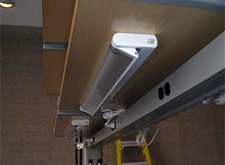
Lighting is a key issue with many design options. For example:
- To reduce the high overall light levels, consider a task or ambient lighting design. Good task lighting lessens glare and eye strain and often improves productivity.
- Look for light fixtures that optimize energy use.
- Light fixtures parallel to the outside wall will allow for each row of lights to be controlled by the sensors more efficiently.
- Natural light should go to a depth of 2-3 times ceiling height into the labs. The light fixtures in this area during the day should not need to go on.
- Purchase light control systems such as occupancy sensors, photo-sensors and time base controls. Daylighting control systems determine the amount of light available in a given space and switch off one or more banks of lights whenever enough sunlight is available. Full-range and step fluorescent dimming systems work well.
- Use compact fluorescents (CFLs) or LEDs instead of incandescent lamps. Incandescent lamps use only 10% of energy in the form of light—the other 90% is heat.
- Research office lighting can be less than 1.1 watts/sf and with lighting controls it may be as low as 0.5 watts/sf.
- Typically, the 15' perimeter of the building can be entirely lit by daylight during the daytime. The use of light shelves can extend the daylight zone up to 45' into the building.
- Consider clerestory windows and skylights to get more natural daylight into the building.
- Use pendant lights so the bulbs are below the ceiling and as much light can be spread across the ceiling as possible. Specify a simple fixture to justify the costs because many pendants will cost more than lay-in type, even when taking into account the energy cost savings.
- Use solar powered exterior lighting. Specify different glass for each facade based on the solar impact.
- Consider different glazing for windows that are used to see out versus the clerestory windows that allow light into the space.
- Consider T5 XPS fixtures for energy performance and cost.
See WBDG Energy-Efficient Lighting, Electric Lighting Controls, Windows and Glazing, Sun Control and Shading Devices.
4. Materials and Resources
The Materials and Resources section is where contractors and sub-contractors can have the most impact on a project. It focuses on buildings that are to be renovated, construction waste management and recycling, and other contractor-driven issues. Some of the contractor issues are determined by the percentage of local and regional materials to be purchased and how well a record of recycling is maintained throughout the construction phase. Proactively looking for affordable supplies locally and regionally is encouraged. The initial contract should specify that the contractors keep track of recyclables during construction.
Building Reuse (MR Credit 1)
Since it is difficult (and highly unlikely) to take material from an existing building and relocate it into a new wet lab facility, the most common way to earn LEED points in this category is on the renovation of an existing building. The majority of construction money for research is spent for modest renovation projects.
Construction Waste Management (MR Credit 2)
The general conditions of the specifications should specify that the contractor meet specific construction waste management goals, even though recycling on-site will add some cost to the project. When recycled, the material is comparable in price with other products that do not contain recycled materials. This change has evolved over the last five years, because of marketplace demand for more sustainable products, processes, and buildings.
Recycled Content (MR Credits 4), Rapidly Renewable Materials (MR Credit 6)
Manufacturers are becoming very competitive using recycled materials in their products. The following is a list of some products to consider:
- Asphaltic concrete paving
- Structural Steel
- Concrete
- Counter top materials
- Carpet
- Reinforcing steel in concrete
- Fiberglass batt insulation
- Mineral wool insulation
- Gypsum board
- Structural fiberboard
Casework products are now being manufactured that are considered "green products." Examples include:
-
Hardwood, veneer, and plywood products that originate from FSC managed forests that are 100% sustainable. This practice ensures rapid regeneration following the harvesting of timber, protection of soils and site productivity, and protection of significant ecological and historic sites.
-
Steel products can be considered "green products." Steel laboratory casework and fume hoods can be made of sheet metal. Sheet steel contains 20-25% scrap steel (60% of which comes from old cars and appliances; the other 40% is from manufactured fall-off).
Certified Wood (MR Credit 7)
Sourcing wood from FSC certified forests and fabricators may add some cost. This will vary depending on the casework manufacturer.
See WBDG Evaluating and Selecting Green Products
5. Indoor Environmental Quality
Many of the indoor environmental quality goals do not add cost or have a clear, quantifiable payback, but they do address quality of life issues. For example, the traditional economic argument for daylighting is that it is really about the costs associated with employee health and well-being.
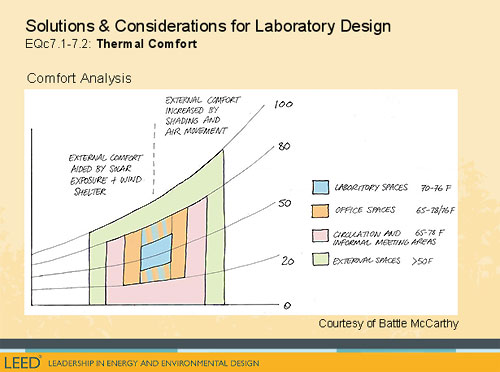
Daylight spaces have been linked with improvements to health and well-being. Assume that this means a 1% increase in productivity 20 hours per year less sick time or non-productive work time) for a lab with a staff of 250. That translates into about $250,000/year in personnel cost savings—a substantial return on investment.
The contractor impacts the construction IAQ management plan during and after construction. Purchasing the most appropriate adhesives and sealants, paints and coatings, carpet, and composite wood is the responsibility of the contractor and sub-contractors. (EQ Credits 4.1, 4.2, 4.3, 4.4)
Two-thirds of the indoor environmental quality goals should be easily achieved, due to the change in market and development of better products.
Carbon Dioxide Monitoring (EQ Credit 1)
This is recommended and can be easily installed at a cost of a few thousand dollars.
Construction IAQ Management Plan During Construction (EQ Credit 3.1)
Construction IAQ Management Plan After Construction (EQ Credit 3.1)
Most wet labs require 100% outside air and should be flushed out during the final commissioning. Non-lab spaces like offices, conference rooms, and atrium will require a two- week flush-out.
Low Emitting Materials (EQ Credits 4.1, 4.2, 4.3 and 4.4)
Products that address these goals are easily attainable today.
Considerations for Interior Materials for Sustainability Issues or LEED Certification
Division 5 – Metals
- Use aluminum in a manner that facilitates future recycling, avoid mixed-material assemblies.
- Factory finishes, rather than field finishes.
- Avoid coatings, where possible and used physical process finishes such as; abrasive blasting, grinding, buffing, and polishing.
- Avoid plated metals. When plating is necessary, ensure that the process does not include cadmium, chromium, cyanide or copper/formaldehyde in the plating solution.
- Specify aluminum fully or with a high percentage of recycled materials.
Division 6 – Wood & Plastics
- Specify wood from sustainably managed, FSC-certified forests.
- Do not use wood treated with CCA (copper chromium arsenate); use ACQ (ammonium copper quaternium) or CDDC (copper hydroxide sodium dimethyldithocarbamate) and have all treated wood sealed.
- Minimize the use of plywood for substrates by using composite materials such as wheat-straw fiberboard.
- Use wood composite materials that do not use urea-formaldehyde binding resins.
- Do not use endangered wood species. Consult the Convention on International Trade in Endangered Species (CITES).
- Use lesser-known sustainable species to prevent overexploitation of more popular woods. Use woods of the World database by Tree Talk, Inc.
- Avoid the use of lauan plywood; use birch or Apple-ply.
- Limit use of solvent-based adhesives with high VOC emissions.
- Limit the use of plastic laminate.
- Avoid the use of PVC.
Division 7 – Thermal & Moisture Protection
- Use fiberglass insulation that does not contain formaldehyde.
- Avoid foam insulations that use CFCs or HCFCs.
- Install sealants as early as possible to allow for outgassing.
- Specify low VOC sealants.
- Avoid sealants with benzene, halogenated solvents, fibrous talc, formaldehyde, mercy, lead, or hexavalent chromium.
Division 8 – Doors & Windows
- Specify wood doors with FSC wood.
- Specify low VOC stains and finishes.
- Study the possibility of Fiberglass windows. They are less expensive than aluminum and reduce energy cost.
Division 9 – Finishes
Plaster
- Use plasters with no VOC emitting additives, such as epoxy.
Gypsum Wallboard
- Consider gypsum board with high recycled content.
- Recycle construction waste of gypsum board.
Acoustic Ceiling Panels
- Specify ceiling tiles with high quantities of recycled content. 65% or greater.
- Instead of vinyl faced tiles, use painted tiles with scrubble paint finish or metal pan ceiling.
- Install ACT after wet finishes have been applied. ACT can act as VOC sink for off gassing of other materials.
- Do not install ACT until the building is conditioned. High levels of moisture in ACT can lead to microbial growth.
Wood Flooring
- Consider using bamboo flooring, when wood flooring is required.
- Install wood flooring in a manner to minimize the need for adhesives.
Resilient Flooring
- Consider linoleum instead of vinyl flooring.
- Consider floor tile instead of sheet goods, when possible, to minimize waste in replacing worn or damaged materials.
- If vinyl flooring must be used, specify products with high recycled contents and tile. Sheet vinyl produces higher VOC emissions, because of the additional plasticisers required to make the sheet roll.
- Use low-VOC adhesives, on all flooring products.
- Consider the standard dimensions of the product used when designing a pattern to minimize waste.
Carpet
- Use carpet tile instead of broadloom to minimize waste and facilitate replacement.
- Keep carpet away from water sources, such as exterior doors, drinking fountains, exterior doors.
- Specify carpet with CRI (Carpet and Rug Institute) "Green Label."
- Specify carpets that have backings other than latex.
- Consider carpet recycling program.
- Use low VOC adhesives, on all flooring products.
- Consider the standard dimensions of the product used when designing a pattern to minimize waste.
Wall Coverings
- Avoid the use of vinyl wall covering.
- Consider alternate natural wall covering materials when wall coverings are required.
- Consider scrubbable wall coatings.
Paint
- Use water-based, zero- or low-VOC latex paints and primers.
- Specify water based paints that do not contain aromatic hydrocarbons, formaldehyde, halogenated solvents, mercury, lead, cadmium, chromium VI, antimony and their oxides.
- Factory finish components when possible.
Division 10 – Specialties
Toilet Compartments
- Consider solid plastic toilet compartments made from HDPE.
- When using metal toilet partitions, specify power-coated finishes or stainless steel.
Fire Protection Specialties
- Specify dry chemical or CO2 fire extinguishers in lieu of halon.
Division 11 – Solid Waste Handling
- Specify a recycling center.
Division 12 – Furniture
Window Treatment
- Consider automatic shading control for the sun control and daylighting.
Furniture
- Consider refurbishing an existing system rather than specifying a new system.
- Choose furniture products that are easily disassembled for recycling, such as Herman Miller's Aeron chair.
- Use wood furniture from manufacturer's that use FSC certified wood. Most of Knoll International's wood case goods can be manufactured using FSC certified wood products.
- Look for low-toxicity fabrics.
- Consider fabrics with high recycled contents.
- Consider fabrics that are biodegradable.
Green Housekeeping Program
A Green Housekeeping Program is also recommended. It is estimated that 5 million pounds of chemicals (many of which are toxic) are used to clean buildings in the U.S. each year. These chemical products and associated emissions and wastes offer a significant opportunity to impact the sustainability of building operations. The green housekeeping approach goes beyond traditional cleaning to a comprehensive methodology that improves health and safety, reduces environmental impacts, improves occupant productivity, and demonstrates concern for the health and well-being of cleaning personnel. The Green housekeeping strategy is based on the U.S. National Standard Guide on Stewardship for Cleaning Commercial and Institutional Buildings developed by the American Society for Testing and Materials.
Even if all the potentially toxic materials are removed during a building's construction, there is still a potential for indoor air quality contamination through traditional building cleaning methods and the use of potentially toxic chemicals. Some of the properties of cleaning agents that are recommended include:
- Non-toxic
- Phosphate free
- Biodegrades (5-days)
- Does not contain ethers
- Does not contain alkalis or distillates
Thermal Comfort (EQ Credit 7.1, 7.2)
A humidification system may be necessary to meet the technical requirements for specific equipment. Including a humidification system adds value for occupant comfort and, perhaps, employee productivity.
Daylight and Views, Daylight 75% of Spaces (EQ Credit 8.1, 8.2)
As large open labs and interior glazing become more common today, day-lighting and views goals are attainable for many projects. For laboratories, natural indirect light is recommended. Direct natural light could create problems for the research project. Labs that have little or no natural light because of equipment or specific research should not be a part of the calculations.
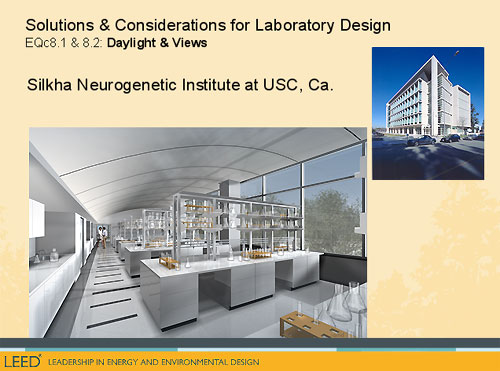
The corridor arrangement can be the determining factor on whether a design solution will attain 75% or higher for daylighting and visibility. A single corridor in the middle of the building provides the best opportunity. Unless there is a large amount of interior glass, a double corridor arrangement with labs in the middle would be extremely difficult to achieve the 75% day-lighting and visibility goal. A three corridor scheme basically eliminates the possibility of reaching the goal.
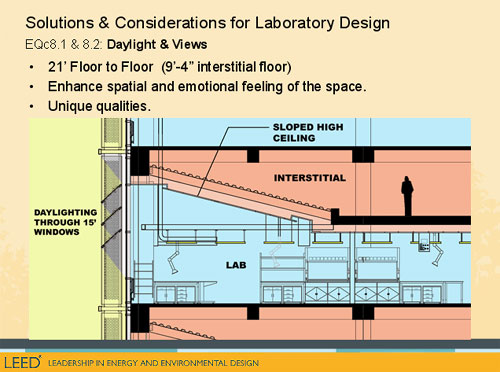
See WBDG Evaluating and Selecting Green Products, Daylighting, Sun Control and Shading Devices, Windows and Glazing, Sustainable O&M Practices.
6. Innovation and Design Process
Most innovation goals can be achieved with no or very little additional cost. The Innovation and Design Process is usually addressed by a knowledgeable A/E team with a good LEED accredited professional.
Some design options to consider:
- Mobile casework to reduce operational costs
- Signage to educate the users of sustainable design solutions. With employees and maintenance staff changing over the life of the building, graphic signs and boards help explain the design intent.
- DDC (direct digital controls) for user education
- Interstitial floors to support flexible and efficient labs
- LEED pilot credits
- Process water use reduction
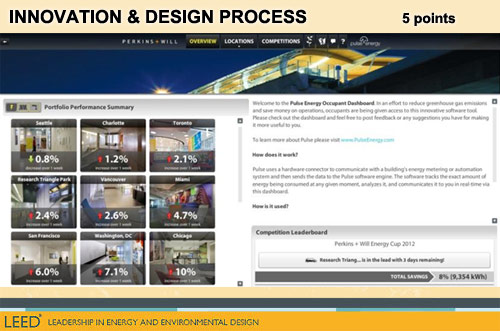
LEED Accredited Professional (ID Credit 5)
Since many individuals have taken and passed the LEED exam, this point should be easy to achieve.
Relevant Codes and Standards
Federal Mandates
- Energy Independence and Security Act of 2007 (EISA)
- Energy Policy Act of 2005
- Executive Order 13693, "Planning for Federal Sustainability in the Next Decade"
Additional Resources
Federal Agencies and Programs
- U.S. Department of Energy
- U.S. Environmental Protection Agency
- Laboratories for the 21st Century (Labs21 Video)—Sponsored by the U.S. Environmental Protection Agency and the U.S. Department of Energy, Labs21 is a voluntary program dedicated to improving the environmental performance of U.S. laboratories.
- Labs21 Tool Kit
- A Design Guide for Energy-Efficient Research Laboratories—A reference that helps facility owners, managers, and designers and apply energy-efficiency features in laboratories.
- Environmental Performance Criteria—A rating system specifically designed to assess environmental performance of laboratories.
Organizations and Associations
- American Council for an Energy-Efficient Economy (ACEEE)
- The American Institute of Architects (AIA) Committee on the Environment (COTE)
- American Society of Heating, Refrigerating, and Air-Conditioning Engineers (ASHRAE)
- American Solar Energy Society (ASES)
- Center for Resourceful Building Technology (CRBT)
- Sustainable Buildings Industry Council (SBIC)
- U.S. Green Building Council








